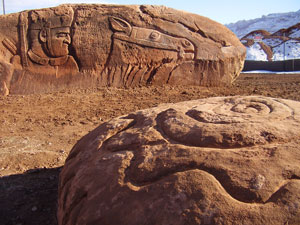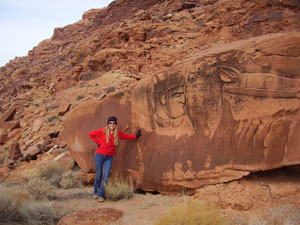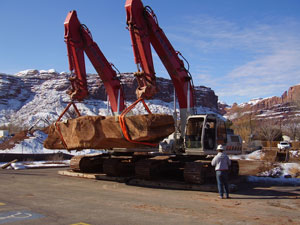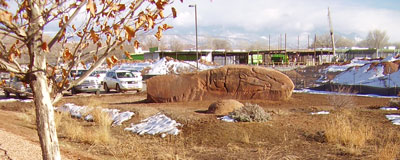Huge sculpted profiles of a man and his horse carved on a giant sandstone boulder in Moab adds a whole new dimension to the concept of rock art in southern Utah.

A dedication, plaque and landscaping are planned to recognize the contribution and enhance surroundings at the new site. Second boulder near the King World carving has star-like image an itinerant rock sculptor engraved in 1992. |
Now easily accessible for all to see, the bas-relief images presumed to have been carved in 1935 on the face of an eight-foot-high boulder on a hillside north of Moab are credited to a mysterious and once-upon-a-time immigrant who lived in the area briefly. On the rock is spelled the name Aharron Andeew, who is credited with being the artist.
He may have been Russian; he may have been Bulgarian. The hat in the carving is described as “Cossack,” according to information the county received in accepting the rock as a donation. Most commonly, the figure over time has been referred to as “king of the world,“ or the “King World” carving, after words the artist pecked into the rock near the base. “King World” also served as the name of a water park operated below the boulder by previous owners Bob and Diane Norman.
“We used to picnic up there when we were in high school. That’s why I always wanted that rock,” Mrs. Norman said. When the Normans developed the water park in 1992, it was no surprise that they chose to name it King World Water Park.
Jennifer Speers bought the property in late 2009, removed the water park, and last month donated the boulder and another piece of modern rock art near the Andeew boulder to Grand County. Officials involved in the process said the new property owners’ attorney had expressed concern about the site becoming “an attractive nuisance” and creating liability issues.

Author Vicki Barker shows scale of rock art bas-relief from 1935 at original site east of Highway 191 in north Moab. |
“It’s interesting how many people know about it, and don’t know about it,” Speers commented after the move. “I thought, ’Yeah, it’s a good idea to move it.’ Now it’s where people can see it.”
A resurgence of interest in the artwork -- most recently cast into the limelight by the swift, precise and dramatic removal and relocation to the Grand Center on 500 West -- may ultimately pinpoint Andeews’ origins and fate. According to officials presenting Speers’ gift to the County Council, the artist was a veteran of World War I and came to America after the war. The numbers “11” and 1935 pecked into the rock at the top suggest the work dates to November 1935.
Dave Olsen, Moab community development director, told the council that Nolan Morse of Moab, now 86, “remembers this guy, and he dressed up like a Russian, and he may have been a Russian…and he had a prancing horse. He’d go around prancing in his Russian uniform.” Morse was 12 at the time.
Research is underway to prepare an historical plaque for placement at the new site of both the King World rock and a smaller boulder carved nearby in 1992 by itinerant sculptor Ken Hiratsuka of New York. The Normans, for whom Hiratsuka sculpted the smaller rock in exchange for “a place to sleep, a meal, a beer and a shower,” refer to it as “The Endless Circle.”

An estimated 30 tons, King World rock required precision movement by heavy-equipment operators to avoid damage. |
According to some historical accounts the Normans gathered about the property, besides Andeew having lived in a rock shelter onsite, Butch Cassidy once took up shelter in that particular canyon area, too.
Speers is working with the Grand County Historical Preservation Commission, Moab City Community Development, the Normans and other sources to collect information on the artwork and compose text for the historical plaque. Verleen Striblen, Grand Center director, is working on plans for a dedication.
Word that Speers planned to remove and donate the rock art spread fast, and several parties vied for possession. The city and trails group that is working on improvements at Lions Park hoped to integrate the boulder into the new design of the park, placing it up the hill a bit but essentially keeping it within context of the area in which it was created. The historical commission had favored that spot as well. County facilities officials decided the 24-foot-long boulder was too big to place at the courthouse. But the senior center director wanted the rock with a passion.
“When I heard…they were looking at different options, I thought, ‘Oh, I love that rock!’” Verleen Striblen said. “I’d been up there a couple of times, and I thought, ‘Oh, cool!’ I said I’ll take it if nobody else wants it.”
She also chanced to talk to Speers. “I told her I really wanted it, and she said it was a good location. She just thought more people would be able to see and enjoy it.”
Additionally, Striblen enjoined her son Michael to put a vote in with his friend Scott Johnston, who works as a ranch foreman for Speers. Within a week of the county accepting the donation, while discussion ensued about where to place the artwork, Speers ultimately opted for the Grand Center.
“It’s an old rock, and a lot of seniors are there, and a lot of them knew the guy who did it,” she said.
“I think it’s great. I think it looks good where it is. They did a good job of placing it…and it looks like it belongs there.”

Construction of the new hospital is underway directly behind the rock art now decorating entry to the Grand Center in west Moab. |
|



